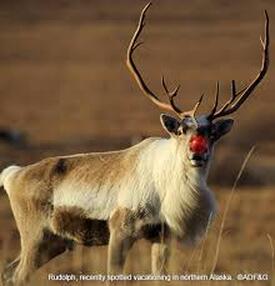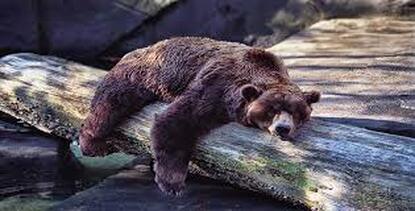|
Sycamore Grove Farm, Madison County 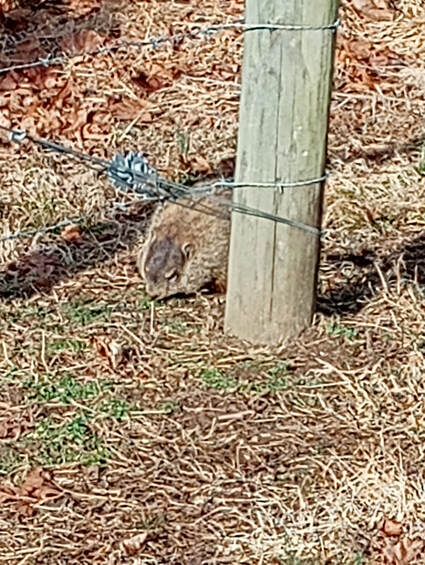 Groundhog; Photo: Charlene Uhl Groundhog; Photo: Charlene Uhl One of the most valuable techniques that I learned from a fellow ORMN birder – Lynne Leaper – is to make regular stops during your bird walk. Stop on a regular basis and just watch and listen. Lynne recommended 5 to 15 minutes and I have found this technique to be an amazingly effective way to see more birds and other animals in nature. On September 4th of last year, I was standing at one of the fence lines on our property. I regularly put a small amount of seed on the top of the fence posts and scatter some on the ground to attract birds. All the seed is usually eaten within 10-15 minutes and I move on. On this morning as I was standing very still and observing the birds, I saw something move to my right. It was a small, immature groundhog which had come out of nearby undergrowth. It may have been drawn to the bird activity. Since they also have a keen sense of smell, it may have smelt the seed. It cautiously walked to the scattered seed and began to eat. My slightest movement, however, sent it scurrying back into the thick brush. After several weeks of this behavior the groundhog became acclimatized to my presence and associated it with a food source. For the next month and a half, it came almost every day. October 17th was the last day I saw it. Since groundhogs have a lot of predators (including hawks, foxes, and coyotes, all of which we have seen on our property), I assumed it had been killed and eaten. Then this morning the groundhog appeared – over three months since I last recorded its presence – and started to eat seed just as it had last fall. It was a little more skittish but not like its first few weeks last fall. Apparently this groundhog had been hibernating and is just now coming out of its burrow. What I found after researching is that groundhogs, while primarily herbivores, are opportunistic eaters and will actually eat small birds. They can also climb trees! I have seen this more than once here on our farm. I look forward to journaling many more interesting observations during my morning bird walk. Birding tip of the day: Keep a written journal so you can look back and find information on birds’ behavior (when and if they migrated into or out of your area) and the behavior of other animals that are a part of the habitat. It will prompt you to use your observations to do research and learn more about your own property. I also record weather (cloud cover, air temperature, chill factor and humidity). I note if there is dew, frost, or snow on the ground and any other unique things (i.e. the date our field is cut, raked, and bailed). I started journaling during Basic Training Class and have found my observations to be an invaluable and specialized source for information on the natural world right here on our farm. Happy birding! Charlene Uhl
2 Comments
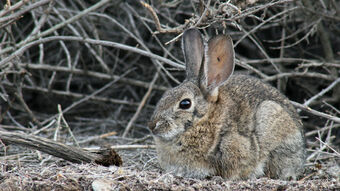 By Erik Stokstad Science Magazine May 20, 2020 A deadly virus is spreading quickly among wild rabbits in southwestern North America, threatening populations and possibly endangered species. Last week the virus, which causes a hemorrhagic disease, reached Southern California. “The outlook right now is so unbelievably bleak,” says Hayley Lanier, a mammologist at the University of Oklahoma. “We’re simply left to watch the wave spread out and worry about imperiled species in its path.” Rabbit hemorrhagic disease virus first spread worldwide in the 1980s, devastating domestic rabbit populations in China and Europe. It raced through Australia, where feral rabbits had flourished after being introduced in the 18th century. Populations began to recover, but then a new strain emerged in France in 2010 that also kills wild species. Strains of this new pathogen—rabbit hemorrhagic disease virus 2 (RHDV2, also called L. europaeus/GI.2)—are more prone to recombination, which could explain the broader range of hosts, says Joana Abrantes, a researcher in virus evolution at the Research Centre in Biodiversity and Genetic Resources in Portugal. The new strain is less deadly in adults, but unlike its predecessor it also kills young rabbits. After the virus hammered populations in the Iberian Peninsula, killing 60% to 70%, two predators that depend on rabbits also declined: the Spanish imperial eagle by 45% and the Iberian lynx by 65%. Both types of RHDV are extremely infectious. They also persist in the environment, surviving in dead animals for at least 3 months. Predators and insects can spread it through their feces. The virus is now poised to spread throughout North America, says Robyn Hall, a veterinary virologist and epidemiologist with the Commonwealth Scientific and Industrial Research Organisation, where RHDV2 sped cross-country in 18 months between 2015 and 2016. First detection The virus was first detected in North America in 2018, in domesticated rabbits in Canada, followed by three U.S. states, but not in wild species. In early March, biologists in New Mexico began to find dead wild rabbits. One of the first known victims was discovered by Gary Roemer, a wildlife biologist at New Mexico State University (NMSU), Las Cruces, while walking his Chesapeake Bay retriever in the desert. The dog “never catches jackrabbits, they’re just too damn fast,” he says. But the rabbit must have been sick and weak, he guesses. Since then, Roemer has found 18 carcasses in 1 half-square kilometer. Biologists and wildlife veterinarians in neighboring states were on the alert and began to receive reports of multiple dead rabbits in many locations. “This is very, very unusual and what happens when we have a disease that is brand new to the landscape,” says Anne Justice-Allen, a wildlife veterinarian with the Arizona Game and Fish Department. “We would never see tularemia or plague spread like this in rabbits.” She has sent several carcasses to the U.S. Geological Survey (USGS) National Wildlife Health Center (NWHC), which is helping with necropsies and preparing samples for genetic testing. Because RHDV is a foreign virus, only a high containment laboratory run by the U.S. Department of Agriculture (USDA) on Plum Island off the Massachusetts coast is allowed to test for the virus. USDA has sequenced genomes of RHDV2 samples collected from 2018 to the present, according to a report submitted to the World Organisation for Animal Health on 5 May. The viral strain in the southwest—the same strain has been found in both domestic and wild rabbits there—differs from samples from other U.S. states and Canada, which suggests a single introduction to the desert region. The genomes will be published as soon as possible, a spokesperson told ScienceInsider. Knowing more about the strains, and possibly their virulence, could help biologists know what kind of impact to expect in wild populations,Justice-Allen says. Challenge experiments, in which rabbits are intentionally infected with the virus, would also help. In 2017, researchers at the Plum Island lab showed that RHDV2 can kill eastern cottontails, a wild species, but experimental infections are not planned for other wild species. Concern for endangered species In the meantime, USGS has warned that all North American species of lagomorph—which include rabbits, hares, and distant relatives called pikas—could be susceptible. Biologists fear the virus could have an especially negative impact on some species that are already struggling. Overall, just two species of North American lagomorph are considered stable; the rest are declining because of threats such as climate change or habitat degradation from livestock grazing. Other species are not well enough studied to know their status, Lanier says. Species of particular concern include the pygmy rabbit, which has populations at risk, such as those in Washington state. The virus is already affecting species in northern Mexico, a center of lagomorph diversity that is home to rare and endangered species such as the volcano rabbit and the Davis Mountains cottontail. “We are very concerned,” says Jesús Fernández, a mammologist at the Autonomous University of Chihuahua, Chihuahua. “We believe that [the virus] can pose a serious threat.” Fernández and colleagues have been telling local cattle ranchers they should burn any rabbit corpses they find, bury them 1 meter deep, and report any with bloody faces. Fernández and colleagues are organizing sampling work to figure out which species in Mexico can be infected and how the populations are faring. A future worry is that if rabbit and jackrabbit populations plummet, coyotes may hunt cattle instead, which might cause ranchers to use poison to kill the coyotes. Poisoned carcasses could in turn endanger scavengers such as eagles and vultures. Roemer says there are not a lot of data on rabbit populations in the U.S. Southwest. He has done surveys in three parts of New Mexico for several years and hopes to find funding to determine the impact of the virus on rabbits and their predators. He and other researchers would also like to know whether certain species act a reservoir for the virus, which could lead to it becoming endemic. “There’s so much we don’t know that it is extremely difficult to make a prediction,” says Matt Gompper, a wildlife ecologist at NMSU. Could a vaccine help? If the virus does become established, some researchers hope a vaccine might help protect populations. Commercial vaccines for domestic rabbits, available in Europe, can’t be used in wild species because they must be injected. “The stress induced by animal capture and manipulation is often lethal,” Abrantes notes. And the vaccines are made from inactivated infectious viruses, which raises concerns the vaccines themselves could spread problematic pathogens. Four institutions in Portugal are working on a different approach. Project Fight 2 aims to develop an oral vaccine for RHDV2, incorporated into bait, for the wild rabbit populations of the Iberian Peninsula. The project, which began in October 2018, has a budget of about €120,000 to develop a prototype vaccine based on viruslike particles that mimic viruses without being infectious. The group expects initial results on the effectiveness by the end of 2021. If successful, it could take two to three more years to license the vaccine, they say. One drawback: Like the vaccines for domestic rabbits, boosters will be necessary every 6 months, and cost could be an issue. Robert Dusek, a wildlife biologist at NWHC, sounds a note of caution: “That’s a long road to go down and pretty expensive.” Carlos Rouco, a wildlife ecologist at the University of Córdoba, is also skeptical. He says the best hope is to prevent the introduction of the virus. “I don’t consider myself an alarmist person, but the virus is unstoppable.” Once it reaches a population, managers should try to reduce other stresses on the population, such as supplying water if necessary. A certain percentage of the population should be resistant to the virus, he says. In Arizona, Justice-Allen has her hopes. “We are still seeing live rabbits in areas where the outbreak has been going on for more than a month. So that is reassuring.” Posted in: Plants & Animals doi:10.1126/science.abc9144 By Elizabeth Preston © 2020 The New York Times
03.02.20 Are humans the only animals that caucus? As the early 2020 presidential election season suggests, there are probably more natural and efficient ways to make a group choice. But we're certainly not the only animals on Earth that vote. We're not even the only primates that primary. Any animal living in a group needs to make decisions as a group, too. Even when they don't agree with their companions, animals rely on one another for protection or help finding food. So they have to find ways to reach consensus about what the group should do next, or where it should live. While they may not conduct continent-spanning electoral contests like Super Tuesday, species ranging from primates all the way to insects have methods for finding agreement that are surprisingly democratic. Meerkats As meerkats start each day, they emerge from their burrows into the sunlight, then begin searching for food. Each meerkat forages for itself, digging in the dirt for bugs and other morsels, but they travel in loose groups, each animal up to about 30 feet from its neighbors, says Marta Manser, an animal-behavior scientist at the University of Zurich in Switzerland. Nonetheless, the meerkats move as one unit, drifting across the desert while they search and munch. The meerkats call to one another as they travel. One of their sounds is a gentle mew that researchers refer to as a "move call:' It seems to mean, "I'm about ready to move on from this dirt patch. Who's with me?" In a 2010 study, Manser and her colleagues studied move calls in a dozen meerkat groups living in the Kalahari Desert in South Africa. Groups ranged from six to 19 individuals. But the scientists found that only about three group members had to mew before the whole party decided to move along. The group didn't change direction, but it would double its speed to reach better foraging grounds. Biologists call this phenomenon - when animals change their behavior in response to a critical mass of their peers doing something - a quorum response. Manser thinks quorum responses show up in human decision-making, too. "If you're in a group and somebody says, 'Let's go for a pizza; and nobody joins in, nothing's going to happen;' she said. But if the pizza craver is joined by a couple of friends, their argument becomes much more convincing. Honeybees In the spring, you may discover a swarm of bees dangling from a tree branch like a dangerous bunch of grapes. These insects are in the middle of a tough real estate decision. When a honeybee colony splits in two, a queen and several thousand workers fly away from a hive together. The swarm finds someplace to pause for hours or days while a few hundred scouts fan out to search for a new home. When a scout finds a promising hole or hollow, she inspects it thoroughly. Then she flies back to the swarm, still buzzing on its tree branch. Walking on the swarm's surface, she does a waggling, repetitive dance that tells the other bees about the site she found - its quality, direction and how far away it is. More scouts return to the swarm and do their own dances. Gradually, some of the scouts become persuaded by others, and switch their choreography to match. Once every scout agrees, the swarm flies off to its new home. In his 2010 book "Honeybee Democracy;' Thomas D. Seeley, a Cornell University biologist, writes that we can learn a lesson from the bees: "Even in a group composed of friendly individuals with common interests, conflict can be a useful element in a decision-making process:' African wild dog Like pet dogs, African wild dogs spend some of their time enthusiastically socializing and some of it lazing around. Members of a pack jump up and greet one another in high-energy rituals called rallies. After a rally, the dogs may move off together to start a hunt - or they may go back to resting. In a 2017 study, researchers discovered that the decision to hunt or stay seems to be democratic. To cast a vote for hunting, the dogs sneeze. The more sneezes there were during a rally, the more likely the dogs were to begin hunting afterward. If a dominant dog had gotten the rally started, the pack was easier to persuade - just three sneezes might do the trick. But if a subordinate dog started the rally, it took a minimum of 10 sneezes to prompt a hunt. The researchers note that dogs might actually cast their votes via some other hidden signal. The sneezes could help the animals clear out their noses and get ready to sniff for prey. Either way, the wild dogs end their achoo-ing with a decision they all agree on. Baboons Primates, our closest relatives, have provided lots of material for researchers studying how groups make decisions. Scientists have seen gibbons following female leaders, mountain gorillas grunting when they're ready to move and capuchins trilling to one another. Sometimes the process is more subtle. A group may move across the landscape as a unit without any obvious signals from individuals about where they'd like to go next. To figure out how wild olive baboons manage this, the authors of a 2015 paper put GPS collars on 25 members of one troop in Kenya. They monitored the monkeys' every step for two weeks. Then they studied the movements of each individual baboon in numerous combinations to see who was pulling the group in new directions. The data showed that any baboon might start moving away from the others as if to draw them on a new course - male or female, dominant or subordinate. When multiple baboons moved in the same direction, others were even more likely to come along. When there was disagreement, with trailblazing baboons moving in totally different directions, others would eventually follow the majority. But if two would-be leaders were tugging in directions less than 90 degrees apart, followers would compromise on a middle path. No matter what, the whole group ended up together. Ariana Strandburg-Peshkin, an animal-behavior researcher at the University of Konstanz in Germany who led the baboon study, points out that unlike in human groups, among baboons no one authority tallies up votes and announces the result. The outcome emerges naturally. But the same kind of subtle consensus-building can be part of our voting process, too. "For instance, we might influence one another's decisions on who to vote for in the lead-up to an election, before any ballots are cast;' she said. by Jeff Stehm 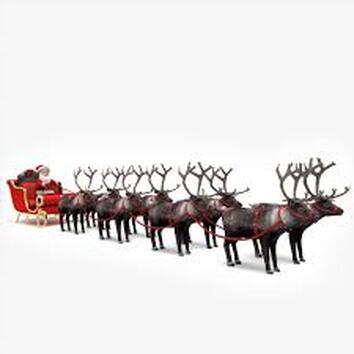 More rapid than eagles his coursers they came, And he whistled, and shouted, and called them by name: "Now, Dasher! now, Dancer! now Prancer and Vixen! On, Comet! on, Cupid! on, Donner and Blitzen! To the top of the porch! to the top of the wall! Now dash away! dash away! dash away all!" As leaves that before the wild hurricane fly, When they meet with an obstacle, mount to the sky; So up to the housetop the coursers they flew…. He sprang to his sleigh, to his team gave a whistle, And away they all flew like the down of a thistle. But I heard him exclaim, ere he drove out of sight-- “Happy Christmas to all, and to all a good night!” Excerpt from “A Visit from St. Nicholas” By Clement Clarke Moore Christmas is approaching and with it, undoubtedly, comes a yearning in the hearts of master naturalists for a better understanding of reindeer. So here are some fun facts about reindeer to entertain the holiday crowds.
And did you know that Rudolf’s red nose is not an anomaly. Most reindeer have red noses as a result of a dense network of capillaries that carry blood to the nose and keep it warm in the cold environment as well as help regulate the reindeer’s body temperature. Now if you really want to impress your holiday guests with the extraordinary depth of your master naturalist training, here are a few scientific points for recitation at Christmas dinner (be sure there is plenty of eggnog):
Sources: www.en.wikipedia.org/wiki/Reindeer www.pbs.org/newshour/science/7-things-didnt-know-reindeer www.britannica.com/animal/reindeer www.mentalfloss.com/article/29470/11-things-you-might-not-know-about-reindeer www.livescience.com/56310-reindeer-facts.html Happy Holidays and Merry Christmas!
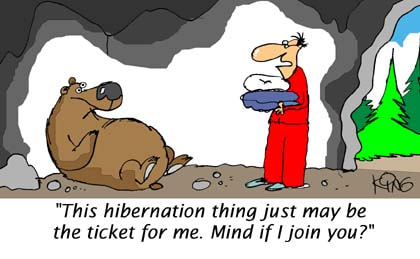 Richmond Times-Dispatch, November 30, 2019 (BY DEVI LOCKWOOD, The New York Times) (submitted by Charlene Uhl, Class X) Physiologically, the hibernation period is the strangest, and the most compelling, to researchers. When a bear hibernates, its metabolic rate and heart rate drop significantly. It does not defecate or urinate. The amount of nitrogen in its blood rises sharply, without damaging the kidneys or liver. The animal becomes resistant to insulin but doesn't suffer from fluctuations in its blood sugar levels. To read the full article, click here. |
Have a blog or blog idea?
Let us know (click) Other Blogs
VA Native Plant Society - click Brenda Clement Jones - click John Muir Laws' Blog - click Megan's Nature Nook - click Categories
All
Archives
September 2023
Blog Administrator:
Kathleen A. VMN since 2018 |
